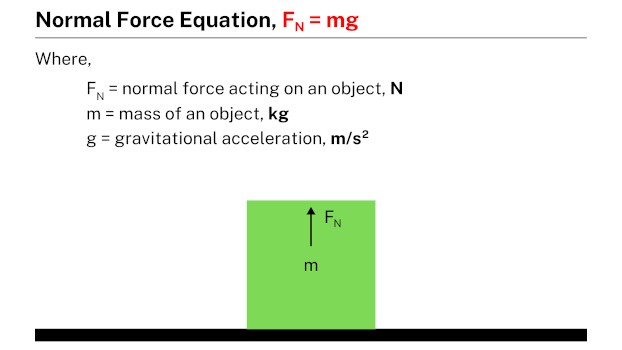The normal force is a contact force exerted by a surface to support the weight of an object resting on it.[1] It acts perpendicular to the surface and prevents the object from sinking into or passing through the surface, serving as a barrier that prevents solid objects from penetrating or passing through each other.[1] The magnitude of the normal force is generally equal to the component of the force that the object exerts on the surface in the direction perpendicular to it, which may include the object’s weight and any additional forces acting on it. This force adjusts according to the sum of all forces acting in the perpendicular direction.
Examples
Flower pot

When a flower pot rests on the floor, the presence of the normal force becomes apparent. This force, exerted by the floor perpendicular to its surface, prevents the flower pot from sinking into or passing through the floor. Instead, it provides support, ensuring the pot remains securely in place.
Plate

When a plate is placed on a dining table, it rests securely on the surface. This is due to the normal force exerted by the table. The normal force acts in an upward direction and is perpendicular to the table’s surface, preventing the plate from passing through. It ensures that the plate remains stably positioned on the table, without sinking into it.
Girl

When a person stands on a flat surface, a normal force is exerted on them, which supports and prevents them from passing through the surface. This force acts perpendicular to the surface, effectively keeping the person in place. It serves as a practical example of the normal force encountered in everyday life and illustrates how it prevents someone from going through the surface.
Television

Televisions are commonly found in homes, and when placed on a table, they rest on it without passing through. This is due to the upward force exerted by the table’s surface, which supports the television and prevents it from going through. This upward force, acting perpendicularly, is known as the normal force.
Apple crate

In fruit markets, various fruit crates are commonly placed on the floor. Consider an apple crate as an example. When the apple crate is positioned on the floor, it is supported and does not pass through the surface. This support is provided by the upward force exerted by the floor, known as the normal force. The normal force acts as a barrier and prevents the apple crate from penetrating the floor.
Mobile phone

When a mobile phone is placed on a desk, it remains supported and doesn’t pass through the surface. This is due to the normal force exerted by the desk on the phone. The normal force acts in a perpendicular direction, effectively preventing the mobile phone from sinking into or penetrating the desk. As a result, the normal force ensures that the mobile phone stays securely in place on the desk.
Candle

The normal force plays a crucial role in supporting a candle placed on a flat surface. When the candle is placed on the surface, the surface exerts an upward force known as the normal force. This force acts perpendicular to the surface and prevents the candle from sinking into or passing through it. The normal force ensures that the candle remains in position and provides the necessary support for it to rest securely on the flat surface.
Book

When a book is placed on a table, it remains in position without sinking through the surface. This is because the table exerts an upward force on the book, known as the normal force. The normal force, acting perpendicular to the table, supports the book and prevents it from passing through. In other words, the normal force acts as a barrier that keeps the book securely on the table.
Water bottle

When a water bottle is placed on a table or floor, the surface exerts an upward force on it in a perpendicular direction. This upward force is called the normal force, which prevents the water bottle from passing through the surface. The normal force supports the water bottle and keeps it securely positioned.
Equation

The normal force equation helps calculate the force exerted on an object in different situations. In the case of an object resting on a flat surface, the normal force (FN) is equal to the weight of the object (mg). This relationship is expressed by the equation FN = mg. When dealing with an object on an inclined surface, the equation for the normal force becomes FN = mg × cos(α), where α represents the angle of the inclined surface.
In scenarios involving external forces, the normal force equation can be modified accordingly. When a downward external force is applied to an object, the equation becomes FN = mg + F sin(θ), where F denotes the magnitude of the external force and θ is the angle between the horizontal surface and the direction of the external force. Conversely, if an upward external force is acting on the object, the equation becomes FN = mg – F sin(θ). It is important to note that α and θ are measured in degrees, while the unit for the external force, F, is Newton (N). The m and g represent the mass and acceleration due to gravity, respectively. By utilizing these normal force equations, one can accurately calculate the normal force exerted on an object in various scenarios.
Practice problems
Problem #1
Determine the normal force acting on a 2 kg flower pot placed on a desk. The gravitational acceleration is given as g = 9.81 m/s2.
Solution
Given data:
- Normal force acting on a flower pot, FN = ?
- Mass of a flower pot, m = 2 kg
- Gravitational acceleration, g = 9.81 m/s2
Applying the formula, when an object is resting on the flat surface:
- FN = mg
- FN = 2 × 9.81
- FN = 19.62 N
Therefore, the normal force acting on a flower pot is 19.62 N.
Problem #2
Calculate the normal force acting on a 3 kg book placed on an inclined surface inclined at a 45° angle.
Solution
Given data:
- Normal force acting on a book, FN = ?
- Mass of a book, m = 3 kg
- Angle of an inclined surface, α = 45°
Applying the formula, when an object is placed on an inclined surface:
- FN = mg × cos(α)
- FN = 3 × 9.81 × cos(45°)
- FN = 29.43 × 0.7071
- FN = 20.8099 N
Therefore, the normal force acting on a book is 20.8099 N.
Problem #3
A wooden crate with a mass of 20 kg is resting on the ground. An external downward force of 8 N is applied to the crate at a 30° angle. Calculate the normal force acting on the wooden crate.
Solution
Given data:
- Mass of a wooden crate, m = 20 kg
- External downward force applied on a wooden crate, F = 8 N
- Angle between horizontal surface and external downward force, θ = 30°
- Normal force acting on a wooden crate, FN = ?
Applying the formula, when an external downward force is acting on an object:
- FN = mg + F sin(θ)
- FN = [20 × 9.81] + [8 × sin(30°)]
- FN = 196.2 + [8 × 0.5]
- FN = 196.2 + 4
- FN = 200.2 N
Therefore, the normal force acting on a wooden crate is 200.2 N.
Problem #4
Find the normal force acting on a 4 kg block when an external upward force of 10 N is applied at a 45° angle.
Solution
Given data:
- Normal force acting on a block, FN = ?
- Mass of a block, m = 4 kg
- External upward force applied on a block, F = 10 N
- Angle between horizontal surface and external upward force, θ = 45°
Applying the formula, when an external upward force is acting on an object:
- FN = mg – F sin(θ)
- FN = [4 × 9.81] – [10 × sin(45°)]
- FN = 39.24 – [10 × 0.8509]
- FN = 39.24 – 8.509
- FN = 30.731 N
Therefore, the normal force acting on a block is 30.731 N.
More topics
- Force
- Normal force
- Balanced force
- Unbalanced force
- Applied force
References
- Gravity and the Normal Force – Rochester Institute of Technology
External links
- What is normal force? (article) – Khan Academy
- Normal Force | Definition, Equation & Examples – Study.com
- Normal Force: Meaning, Examples & Importance – Vaia
- Normal, Tension, and Other Examples of Forces | Physics – Lumen Learning
- Types of Forces – The Physics Classroom
- Normal force – Wikipedia
- What are some examples of normal force? – Quora
Deep
Learnool.com was founded by Deep Rana, who is a mechanical engineer by profession and a blogger by passion. He has a good conceptual knowledge on different educational topics and he provides the same on this website. He loves to learn something new everyday and believes that the best utilization of free time is developing a new skill.
